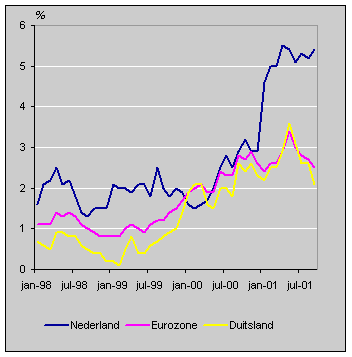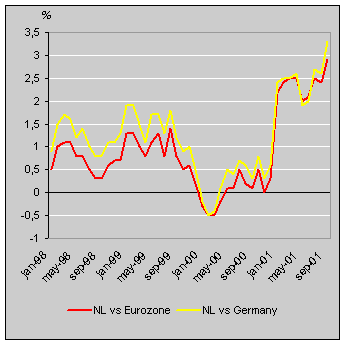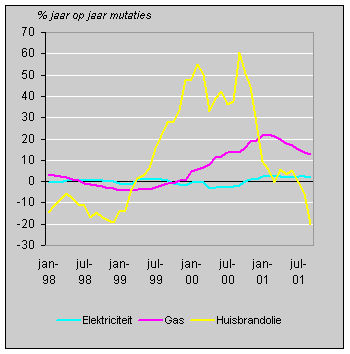Why is Dutch inflation the highest in Europe?

The cost of living has been rising steadily in recent months. In the Netherlands inflation has been higher than in the rest of the European Union since January of this year. Dutch consumer prices were 5.4% higher in September this year than twelve months previously. In Germany inflation was 2.1% and the Eurozone as a whole on average 2.5%.
Inflation in the Netherlands, Germany and the Eurozone

Source: Statistics Netherlands/Eurostat
Inflation in the Eurozone rose almost continuously between mid-1999 and May 2001, but started to fall after that. Dutch inflation started to increase in the course of 2000, leapt to a higher level in January 2001 and has remained at this high level in recent months.
Differences in inflation between the Netherlands, Germany and the Eurozone

Source: Statistics Netherlands/Eurostat
Difference with Germany and the Eurozone
In September the difference between inflation in the Netherlands on the one hand, and Germany and the Eurozone on the other was greater than it has been all this year. Between February and August the difference with Germany and with the Eurozone was around 2.5%, with a fall to around 2% in May and June. In September the difference with the Eurozone increased to 2.9%, that with Germany to even 3.3%.
Causes of high Dutch inflation
There are several causes for the high rate of inflation in the Netherlands. The increase in the rate of VAT introduced on 1 January 2001, from 17.5% to 19%, had a direct effect of 0.6 of a percent point on the Dutch price index. The increase of the eco-tax in January also resulted in 0.4 of a percent point extra inflation. Furthermore price rises were relatively low in 2000 because of the abolition of the TV licence fee, resulting in 0.5 of a percent point less inflation in 2000. These three causes explain part of the inflation leap in January 2001.
Energy price developments explain September gap
The increase in the inflation gap between the Netherlands and the rest of the Eurozone in September can be largely attributed to the developments in energy prices. Decreases in the price of domestic fuel oil in particular resulted in a strong fall in inflation in the Eurozone and in Germany. In the Eurozone liquid fuels were about 5% cheaper in August 2001 than twelve months previously. And in September this difference had even risen to 20%. In Germany the twelve-month price decreases were –2% (August) and –22% (September).
Energy price developments in the Eurozone

Source: Eurostat
Only very little domestic fuel oil is sold in the Netherlands, and the price decreases for this product thus have very little effect on Dutch inflation. Most Dutch homes are heated by gas. Natural gas prices follow the developments of global energy prices with a delay of a few months, and the strongest fluctuations in these prices are attenuated. The prices of natural gas were not adjusted between August and September, and so did not have an effect on the rate of inflation.
Difference between Germany and the Netherlands up sharply since last year
In September 2000 inflation in the Netherlands was 0.3 of a percent point higher than in Germany. By September 2001 this had increased to 3.3%. In the space of one year the difference in inflation between the Netherlands and Germany had therefore increased by 3.0 percent points. 0.5 of a percent point was caused by the effect of the TV licence fee. The higher VAT rate accounted for 0.6 of a percent point and the strong increase in eco-tax for 0.1 of a percent point. The difference between the development of energy prices further accounts for 0.4 of a percent point. The remaining 1.4 percent points cannot be attributed to these factors.
Components of inflation in the Netherlands and Germany |
||||||
September 2000 |
September 2001 |
|||||
Netherlands |
Germany |
difference |
Netherlands |
Germany |
difference |
|
Total |
2,9 |
2,6 |
0,3 |
5,4 |
2,1 |
3,3 |
of which |
||||||
Food and non-alcoholic beverages |
0,3 |
0,0 |
0,3 |
1,2 |
0,8 |
0,5 |
Alcohol and tobacco |
0,1 |
0,1 |
0,0 |
0,4 |
0,1 |
0,3 |
Domestic energy |
0,8 |
1,0 |
-0,2 |
0,8 |
0,4 |
0,4 |
Other domestic costs |
0,4 |
0,2 |
0,2 |
0,5 |
0,2 |
0,3 |
Health |
0,1 |
0,0 |
0,0 |
0,4 |
0,0 |
0,3 |
Motor fuels |
0,7 |
0,8 |
-0,1 |
-0,2 |
-0,2 |
-0,1 |
Other transport |
0,3 |
0,2 |
0,1 |
0,4 |
0,2 |
0,1 |
Recreation and culture |
0,2 |
0,1 |
0,1 |
0,6 |
0,2 |
0,4 |
TV licence fee |
-0,5 |
-0,5 |
||||
Other |
0,5 |
0,1 |
0,3 |
1,3 |
0,4 |
0,9 |
Source: Statistics Netherlands/Eurostat |
||||||
Jan Walschots